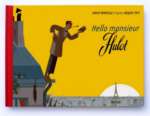
Hello, Mr. Hulot
Written and illustrated by David Merveille
NorthSouth, 2013, 56 pp.
ISBN: 978-0-7358-4135-2
In the 1950’s and 60’s there was a French comic actor and filmmaker known as Jacques Tati. His most famous character was Monsieur Hulot. Hulot is known for his pipe, striped socks, short pants and wrinkled overcoat. Hello, Mr. Hulot is based on Jacques Tati’s beloved French film character by the same name. The character may be more reminiscent to an American audience as a combination of Charlie Chaplin, Mr. Bean, and Inspector Jacques Clouseau from the Pink Panther movies. Tati made several films featuring his Hulot character: Les Vacances de Monsieur Hulot (1953), Mon Oncle (1959), Play Time (1967) and Trafic (1971). Free of dialogue for the most part, the films are an experience in style and design as each film’s scenery is of outstanding quality. The character’s peculiarities and laughable adventures such as riding a bike, waiting for a bus, or visiting the zoo make for an entertaining and humorous time.
The creator of Hello, Mr. Hulot, David Merveille, teaches graphics and illustration at the Institute Saint-Luc of Brussels and also creates posters and illustrations for the daily newspaper Libre Belgique. First published in France under the title Hello Monsieur Hulot, David Merveile’s picture book was completed as a labor of love from a long-time fan of the film character. David Merveille who both authored and illustrated Hello, Mr. Hulot has also created the books: Jukebox, Ms. Blanche, The Spotless Cow, and Thomas the Circus Boy.
Merveille’s 1950esque graphic illustration style book has 22 captivating scenes in which a situation or joke is presented in a two-page scenario. On the first page the scenario is laid out and on the second page the situation is revealed. Several of the situations can be figured out prior, while other endings come as a complete surprise. Merveille captures the essence of Hulot’s movie character in each of his short, and largely wordless comic-strip vignettes. Flat artwork and subdued colors fit the somber post-WWII setting as Hulot, with his ever present umbrella, strolls the streets of Paris. Mr. Hulot is drawn with minimum facial expressions, which is appropriate as Hulot is an everyman character. Hulot’s minimal expression allow readers to put themselves in his shoes. The drawings are detailed scenes constructed from simple shapes and clean lines.
One issue with the story is that the humor in some instances may be too mature for children. Similarly, several of the scenarios such as a French military parades that require onlookers to salute patriotically, footprints from the first moonwalk, or Don Quixote tilting at windmills rest on references that may require an explanation for children. In this way Hello, Mr. Hulot is well suited for adults ass well as children.
With a focus on the graphic approach to sharing story, a good book to pair with Hello, Mr. Hulot is Go: A Kidd’s Guide to Graphic Design by Chip Kidd (2013). Graphic designer Kidd introduce young readers to design elements. Another well paired book in graphic design is the wordless book The Farmer and the Clown by Maria Frazee (2014). Two wordless books by David Weisner, Flotsom (2008) and Tuesday (1997) are also a good choice to pair with Hello, Mr. Hulot. Both books focus on detailed illustrations to share the stories at hand inviting young readers into noticing detail. Robot Dreams (Sara Varon, 2007) is a good introduction to reading graphic style illustrations.
Megan McCaffrey, Governors State University, Illinois
WOW Review, Volume VII, Issue 2 by Worlds of Words is licensed under a Creative Commons Attribution-NonCommercial-ShareAlike 4.0 International License. Based on work at https://wowlit.org/on-line-publications/review/vii-2/
